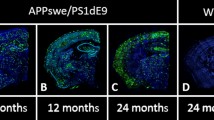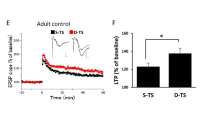Abstract
Amyloid β (Aβ) is a critical factor involved in the pathogenesis of Alzheimer's disease (AD). We have previously demonstrated that continuous intracerebroventricular infusion of Aβ1–40 induced a time-dependent expression of the inducible nitric oxide (NO) synthase (iNOS) and an overproduction of NO in the rat hippocampus. The pathophysiological significance of the overproduction of NO on brain function was manifested by an impairment of nicotine-evoked acetylcholine(ACh) release and memory deficits.4 Molecular mechanisms by which NO participates in the Aβ-induced brain dysfunction, however, remain to be determined. Here we show that chronic Aβ1–40 infusion caused a robust peroxynitrite formation and subsequent tyrosine nitration of proteins in the hippocampus. Immunoprecipitation and Western blot analyses further revealed that synaptophysin, a synaptic protein, was a main target of tyrosine nitration. Chronic infusion of Aβ1–40 resulted in an impairment of nicotine-evoked ACh release as analyzed by microdialysis. Daily treatment with the iNOS inhibitor aminoguanidine (AG) or the peroxynitrite scavenger uric acid (UA) prevented the tyrosine nitration of synaptophysin as well as the impairment of nicotine-evoked ACh release induced by Aβ. Our findings suggest that the tyrosine nitration of synaptophysin is related to Aβ-induced impairment of ACh release.
This is a preview of subscription content, access via your institution
Access options
Subscribe to this journal
Receive 12 print issues and online access
$259.00 per year
only $21.58 per issue
Buy this article
- Purchase on Springer Link
- Instant access to full article PDF
Prices may be subject to local taxes which are calculated during checkout




Similar content being viewed by others
References
Masters CL, Multhaup G, Simms G, Pottgiesser J, Martins RN, Beyreuther K . Neuronal origin of a cerebral amyloid: neurofibrillary tangles of Alzheimer's disease contain the same protein as the amyloid of plaque cores and blood vessels. EMBO J 1985; 4: 2757–2763.
Glenner GG . Alzheimer's disease: its proteins and genes. Cell 1988; 52: 307–308.
Selkoe DJ . Alzheimer's disease: genes, proteins, and therapy. Physiol Rev 2001; 81: 741–766.
Tran MH, Yamada K, Olariu A, Mizuno M, Ren XH, Nabeshima T . Amyloid β-peptide induces nitric oxide production in rat hippocampus: association with cholinergic dysfunction and amelioration by inducible nitric oxide synthase inhibitors. FASEB J 2001; 15: 1407–1409. (April 6, 2001, 10.1096/fj.00-0719fje).
Behl C, Davis JB, Lesley R, Schubert D . Hydrogen peroxide mediates amyloid β protein toxicity. Cell 1994; 77: 817–827.
Yamada K, Tanaka T, Han D, Senzaki K, Kameyama T, Nabeshima T . Protective effects of idebenone and α-tocopherol on β-amyloid-(1–42) induced learning and memory deficits in rats: implication of oxidative stress in βamyloid-induced neurotoxicity in vivo. Eur J Neurosci 1999; 11: 83–90.
Yamada K, Nabeshima T . Animal models of Alzheimer's disease and evaluation of anti-dementia drugs. Pharmacol Ther 2000; 88: 93–113.
Galimberti D, Baron P, Meda L, Prat E, Scarpini E, Delgado R et al. Alpha-MSH peptides inhibit production of nitric oxide and tumor necrosis factor-alpha by microglial cells activated with beta-amyloid and interferon gamma. Biochem Biophys Res Commun 1999; 263: 251–256.
Yates SL, Burgess LH, Kocsis-Angle J, Antal JM, Dority MD, Embury PB et al. Amyloid beta and amylin fibrils induce increases in proinflammatory cytokine and chemokine production by THP-1 cells and murine microglia. J Neurochem 2000; 74: 1017–1025.
Akama KT, Albanese C, Pestell RG, Eldik LJV . Amyloid beta-peptide stimulates nitric oxide production in astrocytes through an NFkappaB-dependent mechanism. Proc Natl Acad Sci USA 1998; 95: 5795–5800.
McGeer PL, McGeer EG . The inflammatory response system of brain: implications for therapy of Alzheimer and other neurodegenerative diseases. Brain Res Rev 1995; 21: 195–218.
Smith MA, Harris PLR, Sayre LM, Beckman JS, Perry G . Widespread peroxynitrite-mediated damage in Alzheimer's disease. J Neurosci 1997; 17: 2653–2657.
Greengard P, Valtorta F, Czernik AJ, Benfenati F . Synaptic vesicle phosphoproteins and regulation of synaptic function. Science 1993; 259: 780–785.
Janz R, Sudhof TC, Hammer RE, Unni V, Siegelbaum SA, Bolshakov VY . Essential roles in synaptic plasticity for synaptogyrin I and synaptophysin I. Neuron 1999; 24: 687–700.
Lynch MA, Voss KL, Rodriguez J, Bliss TV . Increase in synaptic vesicle proteins accompanies long-term potentiation in the dentate gyrus. Neuroscience 1994; 60: 1–5.
Kean RB, Spitsin SV, Mikheeva T, Scott GS, Hooper DC . The peroxynitrite scavenger uric acid prevents inflammatory cell invasion into the central nervous system in experimental allergic encephalomyelitis through maintenance of blood–central nervous system barrier integrity. J Immunol 2000; 165: 6511–6518.
Di Stasi AM, Mallozzi C, Macchia G, Petrucci TC, Minetti M . Peroxynitrite induces tryosine nitration and modulates tyrosine phosphorylation of synaptic proteins. J Neurochem 1999; 73: 727–735.
Thiel G . Synapsin I, synapsin II, and synaptophysin: marker proteins of synaptic vesicles. Brain Pathol 1993; 3: 87–95.
Edelmann L, Hanson PI, Chapman ER, Jahn R . Synaptobrevin binding to synaptophysin: a potential mechanism for controlling the exocytotic fusion machine. EMBO J 1995; 14: 224–231.
Zhao WQ, Cavallaro S, Gusev P, Alkon DL . Nonreceptor tyrosine protein kinase pp60c-src in spatial learning: synapse-specific changes in its gene expression, tyrosine phosphorylation, and protein-protein interactions. Proc Natl Acad Sci USA 2000; 97: 8098–8103.
Nitta A, Itoh A, Hasegawa T, Nabeshima T. β-Amyloid protein-induced Alzheimer's disease animal model. Neurosci Lett 1994; 170: 63–66.
Alder J, Lu B, Valtorta F, Greengard P, Poo MM . Calcium-dependent transmitter secretion reconstituted in Xenopus oocytes: requirement for synaptophysin. Science 1992; 257: 657–661.
Alder J, Xie ZP, Valtorta F, Greengard P, Poo M . Antibodies to synaptophysin interfere with transmitter secretion at neuromuscular synapses. Neuron 1992; 9: 759–768.
Sudhof TC, Lottspeich F, Greengard P, Mehl E, Jahn R . A synaptic vesicle protein with a novel cytoplasmic domain and four transmembrane regions. Science 1987; 238: 1142–1144.
Becher A, Drenckhahn A, Pahner I, Margittai M, Jahn R, Ahnert-Hilger G . The synaptophysin–synaptobrevin complex: a hallmark of synaptic vesicle maturation. J Neurosci 1999; 19: 1992–1931.
McMahon HT, Boshakov VY, Janz R, Hammer RE, Siegelbaum SA, Sudhof TC . Synaptophysin, a major vesicle protein, is not essential for neurotransmitter release. Proc Natl Acad Sci USA 1996; 93: 4760–4764.
Itoh A, Nitta A, Nadai M, Nishimura K, Hirose M, Hasegawa T et al. Dysfunction of cholinergic and dopaminergic neuronal systems in β-Amyloid protein-infused rats. J Neurochem 1996; 66: 1113–1117.
Paxinos G, Watson C . The Rat Brain in Stereotaxic Coordinates. 2nd edn. Academic Press, New york, 1986.
Wang HY, Lee DHS, D'andrea MR, Peterson PA, Shank RP, Reitz AB . β-Amyloid 1–42 binds to α7 nicotinic acetylcholine receptor with high affinity. J Biol Chem 2000; 275: 5626–5632.
Hasegawa M, Kinoshita H, Amano M, Hasegawa T, Kameyama T, Nabeshima T . MK-801 increases endogenous acetylcholine release in the rat parietal cortex: a study using brain microdialysis. Neurosci Lett 1993; 150: 53–56.
Acknowledgements
This study was supported in part by Grants-in-Aid for Science Research (No. 14370031) and Special Coordination Funds for Promoting Science and Technology, Target-Oriented Brain Science Research Program, from the Ministry of Education, Culture, Sports, Science and Technology of Japan and an SRF Grant for Biomedical Research.
Author information
Authors and Affiliations
Corresponding author
Rights and permissions
About this article
Cite this article
Tran, M., Yamada, K., Nakajima, A. et al. Tyrosine nitration of a synaptic protein synaptophysin contributes to amyloid β-peptide-induced cholinergic dysfunction. Mol Psychiatry 8, 407–412 (2003). https://doi.org/10.1038/sj.mp.4001240
Received:
Revised:
Accepted:
Published:
Issue Date:
DOI: https://doi.org/10.1038/sj.mp.4001240
Keywords
This article is cited by
-
Heme oxygenase-1 derived carbon monoxide suppresses Aβ1–42 toxicity in astrocytes
Cell Death & Disease (2017)
-
Selective Inducible Nitric Oxide Synthase Inhibitor Reversed Zinc Chloride-Induced Spatial Memory Impairment via Increasing Cholinergic Marker Expression
Biological Trace Element Research (2016)
-
Quercetin and quercetin-3-β-d-glucoside improve cognitive and memory function in Alzheimer’s disease mouse
Applied Biological Chemistry (2016)
-
Plasma membrane calcium ATPase 4b inhibits nitric oxide generation through calcium-induced dynamic interaction with neuronal nitric oxide synthase
Protein & Cell (2013)
-
Amyloid beta modulated the selectivity of heme-catalyzed protein tyrosine nitration: an alternative mechanism for selective protein nitration
JBIC Journal of Biological Inorganic Chemistry (2012)



